View in other NatureServe Network Field Guides
NatureServe
Montana
Utah
Wyoming
Idaho
Wisconsin
British Columbia
South Carolina
Yukon
California
New York
Spruce Snail - Microphysula ingersollii
Other Names:
Thysanophora ingersolli, Helix ingersolli
Native Species
Global Rank:
G5
State Rank:
S5
Agency Status
USFWS:
USFS:
BLM:
External Links
General Description
A small shell, to about 5 mm diameter and 2.5 mm in height, flattened-heliciform, to about 5 1/2 tightly-coiled whorls. Shell is translucent, appears smooth (without magnification) and whitish; periphery is rounded. The aperture is crescent-shaped, higher than broad, lip not thickened and lacking teeth; umbilicus is about 1/4 the shell diameter. Head is pale gray, tentacles darker, inner whorls of live shells appear pinkish (Hendricks 2012, Burke 2013). Internal anatomy is described by Pilsbry (1940).
Diagnostic Characteristics
A combination of size (to about 5 mm diameter), color (whitish), narrow umbilicus, low spire (almost flattened), no teeth in aperture nor a reflected lip, and 5 tighly-coiled whorls differentiate this species from all others.
Species Range
Montana Range
Range Descriptions
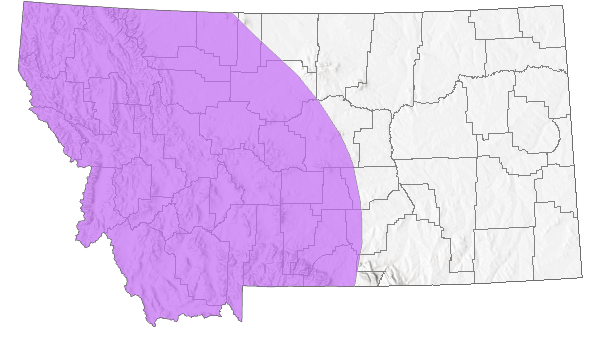
 Native
Native
Range Comments
British Columbia and Alberta through Washington, eastern Oregon and Nevada, and the Rocky Mountain states to Arizona and New Mexico (Burke 2013). In Montana, reported from 19 counties on both sides of the Continental Divide. Elevation range is 655 to 2394 m (2150 to 7855 ft). May be abundant locally; 63 were reported at one site in Granite County in late July (Hendricks 2012).
Observations in Montana Natural Heritage Program Database
Number of Observations: 165
(Click on the following maps and charts to see full sized version)
Map Help and Descriptions
Relative Density
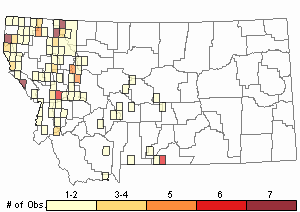
Recency
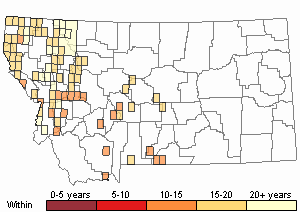

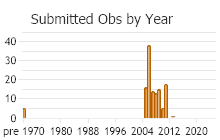
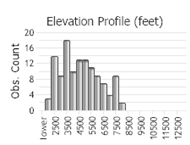 (Observations spanning multiple months or years are excluded from time charts)
(Observations spanning multiple months or years are excluded from time charts)
Habitat
Occupies both wooded and open sites, to above tree line. Canopy species include Douglas-fir, Engelmann spruce, subalpine fir, western larch, ponderosa pine, whitebark pine, lodgepole pine, black cottonwood, aspen, western redcedar and western hemlock; secondary canopy includes alder, willow, hawthorn, and dogwood. Found under woody debris and rocks (sometimes in rotten wood or talus slopes), in leaf litter or duff; most common in areas with moisture and limestone (Forsyth 2004, Hendricks 2012).
Ecology
One of the few native land snails found above tree line in Montana (Hendricks 2012).
Stewardship Responsibility
References
- Literature Cited AboveLegend:
 View Online Publication
View Online Publication Burke, T. E. 2013. Land snails and slugs of the Pacific Northwest. Corvallis, OR: Oregon State University Press. 344 p.
Burke, T. E. 2013. Land snails and slugs of the Pacific Northwest. Corvallis, OR: Oregon State University Press. 344 p. Forsyth, R.G. 2004. Land snails of British Columbia. Royal British Columbia Museum: Victoria, British Columbia, Canada. 188 pp.
Forsyth, R.G. 2004. Land snails of British Columbia. Royal British Columbia Museum: Victoria, British Columbia, Canada. 188 pp. Hendricks, P. 2012. A Guide to the Land Snails and Slugs of Montana. A report to the U.S. Forest Service - Region 1. Montana Natural Heritage Program, Helena, MT. vii + 187 pp. plus appendices.
Hendricks, P. 2012. A Guide to the Land Snails and Slugs of Montana. A report to the U.S. Forest Service - Region 1. Montana Natural Heritage Program, Helena, MT. vii + 187 pp. plus appendices. Pilsbry, H.A. 1940. Land Mollusca of North America (north of Mexico), Volume 1 Part 2. Monograph of the Academy of Natural Sciences of Philadelphia Monograph Number 3(1): 574-994.
Pilsbry, H.A. 1940. Land Mollusca of North America (north of Mexico), Volume 1 Part 2. Monograph of the Academy of Natural Sciences of Philadelphia Monograph Number 3(1): 574-994.
- Additional ReferencesLegend:
 View Online Publication
View Online Publication
Do you know of a citation we're missing? Berry, S.S. 1916. Notes of Mollusca of central Montana. Nautilus 29:124-128.
Berry, S.S. 1916. Notes of Mollusca of central Montana. Nautilus 29:124-128. Berry, S.S. 1919. Mollusca of Glacier National Park, Montana. Proceedings of the Academy of Natural Sciences of Philadelphia 71:195-205.
Berry, S.S. 1919. Mollusca of Glacier National Park, Montana. Proceedings of the Academy of Natural Sciences of Philadelphia 71:195-205. Frest, T.J. and E.J. Johannes. 2001. An annotated checklist of Idaho land and freshwater mollusks. Journal of the Idaho Academy of Science 36(2):1-51.
Frest, T.J. and E.J. Johannes. 2001. An annotated checklist of Idaho land and freshwater mollusks. Journal of the Idaho Academy of Science 36(2):1-51. Russell, R.H. and R.B. Brunson. 1967. A check-list of molluscs of Glacier National Park, Montana. Sterkiana 26:1-5.
Russell, R.H. and R.B. Brunson. 1967. A check-list of molluscs of Glacier National Park, Montana. Sterkiana 26:1-5. Vanatta, E.G. 1914. Montana shells. Proceedings of the Academy of Natural Sciences of Philadelphia 66:367-371.
Vanatta, E.G. 1914. Montana shells. Proceedings of the Academy of Natural Sciences of Philadelphia 66:367-371.
- Web Search Engines for Articles on "Spruce Snail"
- Additional Sources of Information Related to "Snails / Slugs"





